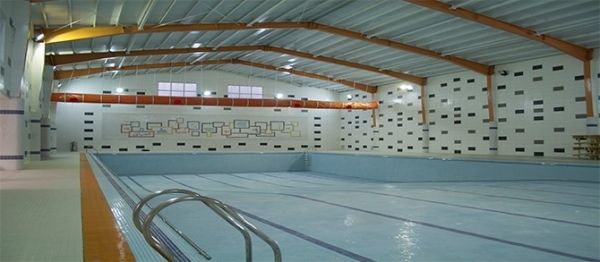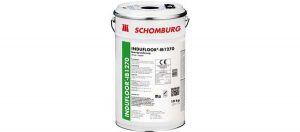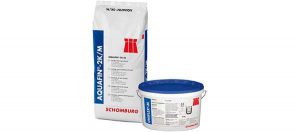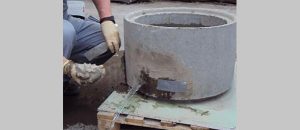• very low emission
• for heated floors
• for interior and exterior use
• for walls and floors
• normal setting
• up to 10 mm thickness
• tested to DIN EN 12004 ,C2TE
Areas of application:
SOLOFLEX is used as a thin- and medium-bed adhesive for the installation of vitrified, earthenware and ceramic tiles with lower water absorption ≤ ۰.۵% (fully vitrified), clinker, mosaics and natural stone, which is not sensitive to discoloration or translucent. SOLOFLEX is suitable for an assured installation to all substrates covered in DIN 18157, part 1 e.g. concrete, aerated concrete, render/plaster, cement-based and calcium sulphate based screeds, heated screeds, masonry work and moisture resistant plasterboard etc as well as for the installation of tiles to mineral-based and dispersionbased bonded SCHOMBURG waterproof membranes in wet duty classifications A0, A and B e.g. wet rooms, communal showers, swimming pool surrounds and swimming pools. Modification with the elastic UNIFLEX-B considerably increases the deformability and tensile adhesion strength of SOLOFLEX. Dependent on the addition rate, class C2E and deformability classes S1 and S2 are achieved, which is especially recommended for large format tiles. This can greatly compensate for shear stresses. See Product preparation. SOLOFLEX is suitable for use in interior rooms in accordance with the French VOC regulation. SOLOFLEX is suitable for use in interior rooms in accordance with the AgBB evaluation scheme (Committee for Health-related Evaluation of Building Products), the French VOC by-law and the Belgian Royal Decree C-2014/24239. Very low emissions in accordance with GEV-EMICODE, which as a rule leads to positive evaluations within the framework of building certification systems according to DGNB, LEED, BREEAM and HQE. Highest quality level 4, row 8 in accordance with the DGNB criterion “ENV 1.2 Local environmental impact“.
Technical Data:
Basis: sand/cement, additives (polymer modified)
Colour: cement grey
Mortar bed thickness: 2 mm to 10 mm
Application / substrate temperature: +5° C to +25° C
Pot life *): approx 2 hrs
Open time *): approx 30 mins
Grout after *): approx 24 hrs
Foot traffic after *): approx. 24 hrs
Full service conditions *): after approx 7 days
Testing: DIN EN 12004, MPA NRW 220001532-02-01 GEV-Licence emissions testing in accordance with EMICODE from the GEV, AgBB scheme, French VOC by-law
Consumption: dependent on the substrate and material installed 2.3 kg/m² with a 6 mm notched trowel 3.1 kg/m² with an 8 mm notched trowel 3.7 kg/m² with a 10 mm notched trowel
Cleaning: immediately after use with water
Packaging: 25 kg bag, 6 kg bag
Storage: 12 months when stored dry in the original unopened packaging. Use opened packaging promptly. *) These values relate to +23° C and 50% relative humidity.
Substrate preparation:
The substrate must be dry, load-bearing, adequately flat, be free from penetrating cracks and separating substances such as oils, paints, laitance and loose areas. It must have a closed surface texture and exhibit surface characteristics and strength consistent with its type. When installing tiles, the substrate, its preparation and workmanship must conform to DIN 18157, part 1. Prime absorbent substrates with ASO-Unigrund. Calcium sulphate screeds must be abraded, vacuumed and as with all calcium sulphate based substrates primed with e.g. ASO-Unigrund/ ASO-Unigrund-S (mix ratio 1:1 with water). If large format tiles are to be laid on calcium sulphate screeds, then we recommend that ASODUR-V360W is used as the primer due to its greater barrier effect. Prior to the installation of tiled finishes on to heated screeds, they must be commissioned to recognised technical regulations. The readiness of a substrate to receive finishes is to be determined by moisture measurements using a carbide hygrometer (CM device). The moisture content should not exceed:
• CT 2.0 CM% for screeds on insulation or separating layers in interiors
• CA without underfloor heating 0.5 CM%
• CA with underfloor heating 0.3 CM%
The moisture measurements are to be carried out in accordance with current FBH-AD work instructions taken from the technical information on the coordination of cutout points with heated floor constructions.
Product preparation:
Mix SOLOFLEX in a clean mixing bucket with clean water until homogenous.
Mixing ratio:
6.75 – ۸.۰ litres of water : 25 kg SOLOFLEX Allow to stand for 3 minutes, then re-mix. Do not mix more SOLOFLEX than can be used within the pot life. Spread the mixed adhesive over the substrate surface and comb through with a notched trowel appropriate to the tile size. Install the tiles within the adhesive open time. When installing large format tiles or tiled finishes in more demanding conditions or where there are temperature fluctuations, we recommend that SOLOFLEX is modified with UNIFLEX-B. The deformation to DIN EN 12002 is considerably increased and the adhesive open time extended. To improve workability, mix UNIFLEX-B with water and then mix with SOLOFLEX until homogenous. Mix ratio, highly deformable especially suitable for wet duty class B0 (conforms to class C1E S2, deformation > 5 mm):
8.33 kg UNIFLEX-B : approx. 2 litres water : 25 kg SOLOFLEX Mix ratio, highly deformable (conforms to classC2E S2, deformation > 5 mm): 4 .17 kg UNIFLEX-B : approx. 3.75 litres
water : 25 kg SOLOFLEX Mix ratio,
deformable (conforms to class C2E S1, deformation > 2.5 mm): 2 kg
UNIFLEX-B : approx. 5.4 litres
water : 25 kg SOLOFLEX
Important advice:
•When installing tiles in more demanding conditions externally to B0 (balconies and terraces), we recommend the highly elastic bonded waterproofing system AQUAFIN-2K/M and UNIFIX-2K. SOLOFLEX modified with UNIFLEX-B can also be used as the adhesive (8.33 kg UNIFLEX-B : 25 kg SOLOFLEX).
• When fixing natural and synthetic stone, take the specific properties of the product and the manufacturer’s installation recommendations into consideration (tendency to discolour, risk of curling). We recommend to fix a trial area.
• When installing large format tiles greater than 50 × ۵۰ cm, a skim coat should be applied to the rear of the tile or the installation should be carried out using the Floating-Buttering technique.
• To avoid curling effects through water absorption, we recommend that when fixing agglomerate/synthetic stone ASODUR-EK98 or ASODUR-Design is used.
• Thoroughly prime calcium sulphate based substrates with ASO-Unigrund-S (mix ratio 1:1 with water) ASO-Unigrund-GE or ASO-Unigrund-K (mix ratio 1:3 with water). To avoid the formation of ettringite, UNIFIX-AEK is especially suited for installing tiles to calcium sulphate based substrates up to a residual moisture of 1.0% when heated and 1.5% when unheated (carbide hygrometer measurements).
• Adhesive, which has started to stiffen, should not be re-lifed through the addition of water or fresh mortar as there is a risk of inadequate strength development.
• Direct contact between cement-based adhesives and magnesite screeds leads to the destruction of the magensite screed through chemical reaction. Prevent moisture ingress from the rear using suitable means. Mechanically abrade the magnesite substrate and prime with the epoxy resin ASODUR-V360W mixed with max. 5% water as necessary (approx. 250 g/m²). After waiting from between 12 and 24 hours, apply a second coat of ASODUR-V360W (approx. 300 – ۳۵۰ g/m²). Blind the second coat whilst still wet, with 0.5 – ۱.۰ mm quartz sand. Wait for a further 12 – ۱۶ hours then continue with the installation.
• I n continuously wet areas (swimming pools, water features etc.), system thin-bed adhesives UNIFIX-2K, UNIFIX-2K/6 should be used with the butteringfloating technique on green concrete shells over the SCHOMBURG waterproof membrane, appropriate for the conditions. SOLOFLEX modified with UNIFLEX-B can also be used as the adhesive – highly deformable S2.
• Protect areas not being treated from the effects of SOLOFLEX.
• SOLOFLEX is a hydraulically hardening mortar and should be protected from water and frost penetration until completely hardened, which may take a few days in unfavourable weather conditions.
• Observe the relevant current regulations. E.g. DIN 18157, DIN 18352, DIN 18560, EN 13813, DIN 1055 The BEB information sheets, distributed by the
Bundesverband Estrich und Belag e.V. The technical information “coordination of cut out points in heated floor constructions”. The ZDB information sheets, distributed by the
professional association of the German tile industry:
[*1] “Bonded waterproof membranes”
[*۲] “Tiling to calcium sulphate screeds”
[*۳] “Movement joints in wall and floor tile finishes”
[*۴] “Heavy duty ceramic floor finishes”
[*۵] “Ceramic tiles, natural stone and cementbound composite slabs on cement-based floor constructions with insulation”
[*۶] “Ceramic tiles, natural stone and cement-bound composite slabs on heated cement-based floor constructions”
[*۷] “Finishes in exterior areas”
[*۸] “Finishes on poured asphalt”
[*۹] “Tolerances in level”
[*۱۰] “Tolerances”
[*۱۱] “Cleaning, protecting, maintenance”
[*۱۲] “Swimming pool construction”
[*۱۳] “Large-format tiles”
Please observe a current valid EU Safety Data Sheet.
GISCODE: ZP1




